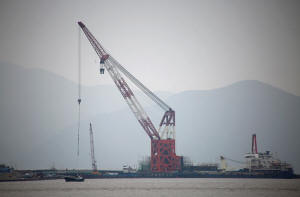China boosted Q1 crude oil storage as imports flatlined: Russell
 Send a link to a friend
Send a link to a friend
 [April 18, 2024] By
Clyde Russell [April 18, 2024] By
Clyde Russell
LAUNCESTON, Australia (Reuters) - China increased the pace at which it
added crude to inventories in March as the world's biggest oil importer
snapped up record imports from Western-sanctioned Russia.
A total of 790,000 barrels per day (bpd) were added to China's
commercial or strategic stockpiles in March, up from the 570,000 bpd
over the first two months of 2024, according to Reuters calculations
based on official data.
Over the first quarter as a whole, China boosted inventories by 670,000
bpd, a figure that to some extent undermines the prevailing market view
that China's oil demand is strong.
This is especially the case since China's crude imports were actually
slightly weaker in the first quarter of this year at 11.02 million bpd,
down from 11.06 million bpd in the same period in 2023.
China doesn't disclose the volumes of crude flowing into or out of
strategic and commercial stockpiles, but an estimate can be made by
deducting the amount of crude processed from the total of crude
available from imports and domestic output.
The total crude available to refiners in March was 15.88 million bpd,
consisting of imports of 11.55 million bpd and domestic output of 4.33
million bpd.
The volume of crude processed by refiners was 15.09 million bpd, leaving
a surplus of 790,000 bpd to be added to storage tanks.

For the first quarter, the total crude available was 15.31 million bpd,
while refinery throughput was 14.64 million bpd, leaving a surplus of
670,000 bpd.
The picture that emerges from the first quarter is that China's demand
for imported crude oil was virtually flat, and that refiners are still
boosting stockpiles even as prices start to increase.
It's worth noting that the crude that landed in China in March was
likely arranged in a window starting from late December through to early
February, a time when crude prices were still lower than their 2023
peaks and had yet to commence their recent rally.
Benchmark Brent futures dropped to $72.29 a barrel on Dec. 13, the
lowest since June, having been on a downward trend since the 2023 peak
of $97.06, reached on Sept. 27.
Since the December low, Brent initially stayed in a broad range around
$75-$85 a barrel, before breaking higher from mid-March to reach a 2024
peak of $92.18 on April 12, amid ongoing concern about an escalation of
tensions in Middle East arising from the conflict between Israel and
Hamas.
[to top of second column] |

A crude oil terminal under construction is pictured off Ningbo
Zhoushan port in Zhejiang province, China January 6, 2018. Picture
taken January 6, 2018. REUTERS/Stringer/File Photo

Brent closed at $87.42 a barrel on Wednesday, after economic data
from China showed the economy grew more than expected in the first
quarter but other indicators, such as property investment, retail
sales and industrial output remained weak.
The question for the market is whether China's economy is on the
road to recovery, and therefore oil demand will improve in coming
quarters.
And even if crude demand does accelerate, will China buy more from
the seaborne market even though prices have risen, or will it turn
to the stockpiles it has built in the first quarter.
RUSSIAN OIL
While China's refiners don't disclose what grade or origin of crude
is being added to inventories, it's likely that Russian oil is one
of the main types being stored.
China's imports from Russia in March were 1.51 million bpd from the
seaborne market and 890,000 bpd via pipeline, giving a combined
total of 2.4 million bpd, according to date compiled by LSEG Oil
Research.
This was up from 2.19 million bpd in February and was the highest
level of imports from Russia since China ramped up purchases in the
wake of Moscow's February 2022 invasion of Ukraine, which led
discounts on Russian crude as Western nations imposed sanctions.
In contrast to higher arrivals from Russia, China's imports from its
former top supplier Saudi Arabia dropped to 1.59 million bpd in
March, the lowest since December, according to LSEG.
The move to Russian crude supports the view that China's refiners
are maximising imports of cheaper grades, which also include oil
from Iran and Venezuela.
The opinions expressed here are those of the author, a columnist for
Reuters.
(Editing by Lincoln Feast.)
[© 2024 Thomson Reuters. All rights
reserved.]
This material may not be published,
broadcast, rewritten or redistributed.
Thompson Reuters is solely responsible for this content.
 |